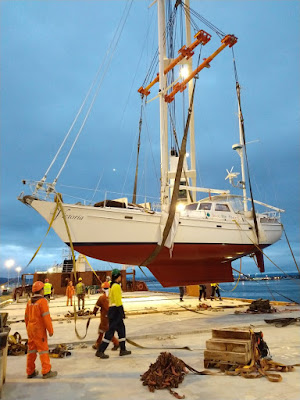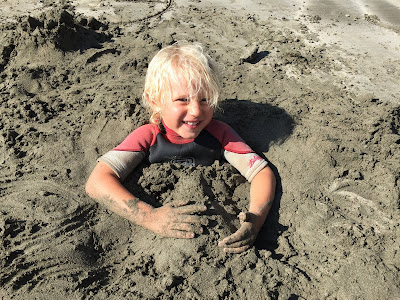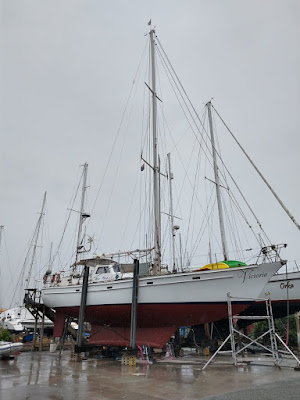Tiny tropical islands, dolphins and a huge Mahi Mahi!
Cukuvou Harbour, Yadua Island, NW Fiji
16 48.9S 178 17.04E
Wind SE 15 knots, light rain
Places visited since previous blog:
Welangilala Island, 16 45.2S 179 06.7W
Taveuni Island, 16 56.0S 179 54.0E
Savusavu, Vanua Levu, 16 46.6S 179 20.1E
Namena Island, 16 58.8S 179 05.5E
We have had so many adventures since our last update that it is hard to know which to share. Fiji is wonderful, and varied, and we are finding that every day and every place is different. The overwhelming theme for us is how amazingly friendly the people are, be it on a tiny island or in the bustling towns. They are all interested in us, have a huge smile and plenty of time to give, and want to know where we are from, and take photos of themselves with our blonder-by-the-day children. They are also incredibly good at making toys from natural resources, and we are building up quite an impressive collection. There's no need to point out that this is a far more sustainable approach to life than heading to the Entertainer to buy some plastic.
The smallest and most remote island we have been to is Welangilala Island. We entered the pass through the surrounding reef without issue, despite the fact there was no sign of the advertised post to mark the entrance. The conditions during cyclone season must be pretty unforgiving for water based navigational marks; we haven't seen many! Waves were breaking either side of us and the depth dropped rapidly from off the scale to seven metres, before increasing again once we were safely in. We were expecting to anchor in flat calm water, protected from the ocean waves by the encircling reef, but to be honest it was fairly windy, and the conditions weren't that different from the open sea. Jack reverted to his hands and knees, declared that it was "crawling weather" and kept asking, "Are we anchored or sailing?". Our dinghy launch was fairly exciting, and we almost lost George backwards over the side when it tugged sharply at its painter, as we were climbing aboard to head ashore. A lightning quick leg-grabbing-reaction from Eloise kept him in. There were two other rally boats there for the night as well; put off by the sea state, they never even went ashore, leaving at first light the next day. They really missed out.
We were not expecting to find anyone on the island. The cruising notes we read had described it as deserted, so we thought we would explore it alone. We were surprised, when we landed our dinghy in the late afternoon sun, to be greeted by two young Fijians with large machetes. Actually, they call them "Cane Knives" (from their use cutting sugar cane), and no self-respecting Fijian man in a rural area would leave home without one. Armed with a cane knife, there is no need to take anything else with you for your day. Need a drink? Simply climb a palm tree and open a green coconut. Need something to eat? Find a brown coconut and chop it in half to eat the flesh. Overgrown bush blocking your path? Slash it down in a heartbeat. Small white children arrive on your island in need of entertainment? Make them spears from sticks, windmills and boats from palm leaves, and give them unlimited coconut milk to drink. Nathaniel and John were charming. They told us the story of the island; bought by an Australian man who has built a resort there, but now apparently has memory problems, and the seven fully furnished lodges, helipad and outdoor showers sit unused. Nathaniel and John are employed to look after the place. They are from Taveuni, 53 miles away by boat, and they return there every couple of weeks in their long boat with 40 horse power outboard engine to buy their groceries. It's a bit like travelling from the Isle of Wight to France in a large dinghy to do your shopping! Extraordinary to us. They promised to show us the whole island the following day.
It was not our most relaxing night at anchor, and in the morning, we had a family vote on whether to leave or go ashore again. The children all felt strongly that we had said we would return, and so we must. Victoria seemed happy enough and the wind was forecast to ease, so Angus and I decided we would do our next passage overnight to avoid another night rolling around there. Nathaniel and John were waiting for us when we arrived. They took us to their house and showed us their livestock; a bucket of red hermit crabs to be used as fishing bait, ten white ducks, a cockerel and a few chickens, and a six-month-old baby turtle. Turtles lay their eggs on their beach in December, and "Kevin" had hatched in January. They planned to keep Kevin until he was bigger, and then hoped he would remain both tame and local when they released him. I'm not sure how kind it is to a keep a baby turtle in a large plastic tub, but they certainly look after him well, feeding him freshly caught fish and taking him for a swim in the sea every day. Kevin was transferred to a smaller bucket and came on our island tour with us. The deserted resort lodges were impressive - ready to go including kettles, telephones and washing machines. The island paths were well kept, thanks to the cane knives, and we were blown away by the beauty of the white sand and the azure blue sea along the beachy side of the island. Angus took some great photos which are on instagram / facebook. Waves broke either side of a sandy spit, which Eloise ran along with our new friends, leaping and laughing and soon soaked to the skin. After that it was turtle exercising time, and Kevin was a fast swimmer! We were nervous Eloise might let him get away, but she kept up with him each time he made a bid for freedom. There was a big turtle swimming nearby, too. George and Jack were off swimming at that time due to several infected sores; all healed now, thankfully. We returned to Victoria laden with coconuts and palm leaf windmills, and I'm pretty sure we will always remember our magical day on Welangilala.
Here on Yadua Island, Angus and the boys had a similar experience today with two young Fijian men on the beach this morning. (Eloise and I were on board Victoria doing a combination of home school, making bread, cleaning the boat and running the water maker.) Peter and Barry were carrying not only huge cane knives, but also an enormous spear, and were off to hunt wild pigs. You can only imagine how much this activity impressed George and Jack, who have been busy spearing imaginary fish and pigs ever since, using the wooden spears that Peter and Barry carved for them. They gave Angus advice on the best snorkelling spots, which paths to take to explore the island, took endless selfies with the boys, before eventually saying their farewells and continuing on their pig hunt. They also told the boys the story of their very unfortunate cousin who died after he was bitten by a shark when spear fishing at night last year; it's a dangerous life here.
As well as tiny islands, we have been to big towns on Vanua Levu, which is one of the main islands of Fiji. We were in Savusavu for a few days, where we were able to purchase all that we needed - fruit and vegetables, diesel, gas bottle refills and Fijian SIM cards (excellent while there was 3G; none here on Yadua..). We had a cold beer or two and met old friends and new at the Savusavu Yacht Club. One of my favourite new friends was Una who ran the laundry there - thanks to her hard work and wonderful machines we now have clean sheets, towels, cloths, tea towels and of course clothes! It was great to see our friends from Winchester again - the Davidsons on Bonaire. We last saw them in Opua, before they left New Zealand. We had a couple of fun crew dinners; on Victoria in Savusavu, and on Bonaire a few days later anchored off the little island of Namena.
Whilst in Savusavu, we hired a car to explore the island of Vanua Levu. More by luck than accurate directions or signage, we found the start of a walk to the Nakawaga waterfall. Armed with our swimmers and goggles, we hiked for about 30 minutes (at child speed) through a forest, following a well-maintained path, which included an unexpected pitstop boasting two flushing loos en route. We didn't see another soul, not even the owners of the land who we were supposed to pay to visit. The waterfall was really impressive and the temperature refreshingly cool. George and Jack swam in the pool in front of it; that was enough for them, especially once they had spotted a yellow eel lurking in the depths.. Then they lay on a stone in the sun, like lizards, warming themselves up. Angus and I took it in turns to swim behind the waterfall with Eloise. We were able to swim in, then scramble up the rock and sit on a little perch, watching the cascading torrent in front of us, hardly able to hear each other for the noise of the tumbling water. It was really exhilarating, and Eloise was bursting with energy afterwards; she would be back there like a shot if she had the chance.
Waterfall safely under our belt, we continued our drive north to Labasa (pronounce Lambasa), which we had been told was a fascinating town, populated almost entirely by Fijians of Indian descent, and a great place to get a really good curry. The zig-zag mountainous road flattened off as we headed north, and soon we were driving along gently undulating plains in the centre of the island. Before long, the land all around us was cultivated with sugar cane, and tractors and lorries laden with harvested cane were making heavy work of the hills towards Labasa. We read the history of the town as we drove. Back in a very different time, when the British ruled Fiji, they moved Indians here as "indentured labourers", mostly from the states of Bihar and Uttar Pradesh, to work in the sugar cane trade. Conditions were little better than slavery. After five years as indentured labourers, they could work for a further five years as free labourers. Following this, they had the option to self-finance their return to India, or become citizens of Fiji. Hardly any could afford to return, so they stayed and found work and built their lives here. Lamasa was the heart of the sugar cane industry, so it is mostly populated with Fijian-Indians, who make up around 37% of the population of Fiji.
Lamasa is not really a tourist destination, and we didn't see any other white people all day. It was like being transported into a busy city in India, minus the cows and the rickshaws. The roads were jampacked with colourful buses, children in immaculate school uniforms waving from the gaping window frames. Although the city boasts the first set of traffic lights on the island, the only role of these was to pause the traffic for pedestrians to cross. Two policemen stood in the middle of the high street, between the bus station and the market, waving and whistling furiously in different directions at the vehicles, keeping things on the move very effectively, until they both stopped for one of their frequent breaks. Then gridlock resumed, and it was every car or bus for himself again. Hindi music blared from the shop fronts, and the market was the amazing; fruit, veg and kava in one building, and sacks overflowing with fragrant and colourful spices and rice in the other. We were treated rather like celebrities; grown men rushed up to the children, especially George, with their hands outstretched in greeting. We had a fantastic curry for lunch at "The Banana Leaf", and our waitress, Bella, was beside herself with excitement to have our little blondies in her restaurant. They had tourists occasionally, she said, but never any with children. She couldn't stop hugging them, taking team selfies, and picking up Jack for a cuddle. She didn't believe that he was three, saying that a three-year-old in Fiji is still a baby and he surely must be five. It is true; he has shot up and is only half a head shorter than George now, so when he isn't being completely mad he could possibly pass for five..
We are anchored tonight off Yadua Island. Tomorrow we head to the Yasawa Islands, north-west Fiji. We are supposedly now on Fiji's "dry" side. A spot forecast for the next few days here showed 0.0cm of rain, and Fiji Met today forecasted "scattered showers". However, since I began this, light rain has turned in to a full-on thunderstorm and I've been on deck in the downpour to clean and block the scuppers, and open the caps to fill the water tanks. Fresh rain water is pouring down the filler pipe which is always fantastic. We just had lightning followed by a clap of thunder so loud that Angus leapt from sleep to the saloon in one single terrified move, thinking that we must have dragged our anchor and hit another boat. Happily not, we are still firmly attached to the bottom and well away from the reef and the other two boats here.
We still have another three weeks to explore wonderful Fiji, before we head to Vanuatu in mid-August, followed by New Caledonia in mid-September, and then back to New Zealand in October. Rosie is coming on board in New Cal, and Serena for Christmas in New Zealand, which we are all super excited about. We would LOVE to share this trip with any of our friends and family who can make it work, kids included of course. Nieces, nephews, cousins - anyone on a gap year or between jobs.. There's lots of room on the boat and we have got the hang of things sailing-wise, and touch wood are doing OK navigating through the coral and reefs, so the more the merrier. Just email or whatsapp one of us if you would like to join the adventure.
Hope all is well back in Blighty.
Lots of love from the good ship Victoria. xxx
PS Happy summer holidays all! No summer hols from boat school - it is a little bit sporadic depending on what is happening on board, so we will all keep on learning what we can when we can. Today we touched on climate change, how to organise a protest / write to your MP, baking bread, spear fishing, Roman Gods, the properties of light and we also made a sun dial, but then it clouded over, so we'll need to continue that project another day!



Hey Laura! At last had a chance to read your blogs, feel sad that I havent managed it before - could have got excited with you on a week by week basis. What a trip! Victoria is stunning. You have reignited so many happy memories for me but you are far braver than us... taking the kids.. not sure I would have coped quite so well as you did with those first 18 hours out of NZ... Can't wait to show Nathan; he will be green with envy xxx to all
ReplyDeleteAnother great post. We are (tentatively) planning a trip to New Zealand Feb/March 2020, then onto Australia if you guys are in either vicinity.
ReplyDelete